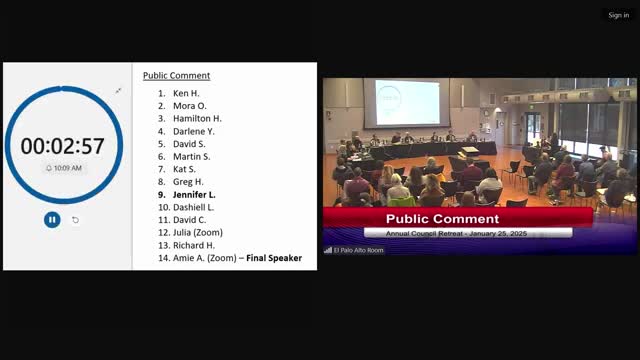Residents demand transparency on SFO jet noise as city prioritizes community engagement
January 25, 2025 | Palo Alto, Santa Clara County, California
This article was created by AI summarizing key points discussed. AI makes mistakes, so for full details and context, please refer to the video of the full meeting. Please report any errors so we can fix them. Report an error »

In the heart of Palo Alto, the City Council meeting on January 25, 2025, buzzed with energy as residents gathered to voice their concerns and suggestions. Among them was a passionate speaker who highlighted the city's recent strides in community engagement, noting that neighborhood meetings had drawn impressive crowds, with one session reaching standing room only. This enthusiasm for participation underscored the importance of incorporating public feedback into the council's annual retreat and priority-setting processes.
The speaker proposed a thoughtful idea: to summarize the questions and answers from these community sessions and integrate them into the council's planning. With advancements in technology, particularly AI, the speaker suggested that meeting replays could be easily transcribed, ensuring that valuable insights from residents are not lost but rather utilized to shape future initiatives.
As the discussion unfolded, the speaker acknowledged the council's extensive to-do list, which includes pressing issues like electrification, housing, climate action, and downtown retail development. However, they emphasized that the real challenge lies not in identifying what needs to be done, but in how to effectively achieve these goals. Central to this success, they argued, is the need for broad community support.
Yet, the speaker expressed a sense of urgency regarding local concerns that may not be on the council's major project list. They pointed to the ongoing issue of jet noise from San Francisco International Airport, which has remained unaddressed in public forums for over three years. This lack of communication has left residents feeling uninformed and anxious about the council's actions—or lack thereof—on such a significant matter.
The speaker's plea resonated with many in attendance, as they articulated a common sentiment: residents want to see tangible actions on issues that directly impact their lives. The call for transparency and responsiveness from the council was clear, as the speaker urged the council to prioritize not only the big projects but also the everyday concerns of its constituents.
As the meeting concluded, the atmosphere was charged with a sense of possibility. The council's ability to foster community support and address pressing local issues could pave the way for a more engaged and satisfied citizenry, ultimately leading to a brighter future for Palo Alto.
The speaker proposed a thoughtful idea: to summarize the questions and answers from these community sessions and integrate them into the council's planning. With advancements in technology, particularly AI, the speaker suggested that meeting replays could be easily transcribed, ensuring that valuable insights from residents are not lost but rather utilized to shape future initiatives.
As the discussion unfolded, the speaker acknowledged the council's extensive to-do list, which includes pressing issues like electrification, housing, climate action, and downtown retail development. However, they emphasized that the real challenge lies not in identifying what needs to be done, but in how to effectively achieve these goals. Central to this success, they argued, is the need for broad community support.
Yet, the speaker expressed a sense of urgency regarding local concerns that may not be on the council's major project list. They pointed to the ongoing issue of jet noise from San Francisco International Airport, which has remained unaddressed in public forums for over three years. This lack of communication has left residents feeling uninformed and anxious about the council's actions—or lack thereof—on such a significant matter.
The speaker's plea resonated with many in attendance, as they articulated a common sentiment: residents want to see tangible actions on issues that directly impact their lives. The call for transparency and responsiveness from the council was clear, as the speaker urged the council to prioritize not only the big projects but also the everyday concerns of its constituents.
As the meeting concluded, the atmosphere was charged with a sense of possibility. The council's ability to foster community support and address pressing local issues could pave the way for a more engaged and satisfied citizenry, ultimately leading to a brighter future for Palo Alto.
View full meeting
This article is based on a recent meeting—watch the full video and explore the complete transcript for deeper insights into the discussion.
View full meeting
